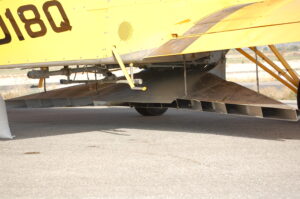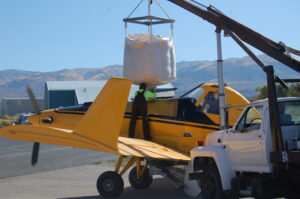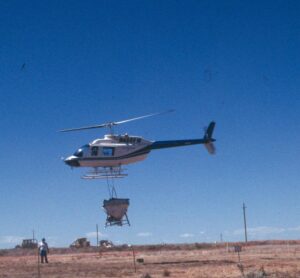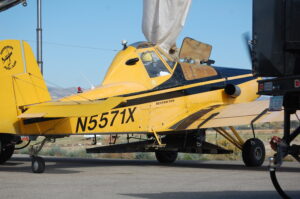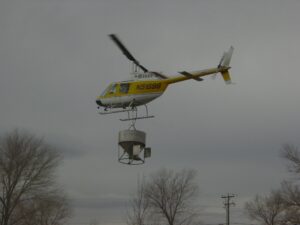Description
Fixed-wing aircraft use venturi spreaders to distribute seed while helicopters use rotary-spinner spreaders. Venturi spreaders clamp to the gate box at the base of the hopper. The gate boxes are 25-, 38-, or 41-inches wide depending on the size of the aircraft. As the adjustable door (gate) on the gate box opens, seed from the hopper falls into the venturi spreader and airflow through the spreader distributes the seed. The amount the door is opened determines the seed flow rate. In some cases, the flow of difficult-to-meter seed can be improved by an agitator installed above the gate box. Hard, slick seed can be accurately metered with a positive metering system installed on the gate box. The system uses a rotating, fluted rotor to positively meter seed or pelleted material. Rotor speed is controlled by the pilot, and the system can be calibrated while the plane is on the ground. Rotary spreaders are self-contained units that hang below the helicopter and spread seed with a hydraulic- or electric-powered spinner. Additional information is covered in Chemical Control.
Application
Aerial seeding can cover extensive areas in a short time and operate where ground equipment is not practical. Timing is critical for success. A freshly disturbed seedbed and seeding just prior to rainfall or before the soil freezes in the fall for dormant seeding holds the greatest potential for success. Vanes in the venturi spreader can be adjusted to control the swath pattern, and the pattern should be tested for even distribution of materials upon initial spreader installation. Seeding rate is determined by the amount of seed flowing through the adjustable door opening on the gate box, speed of the aircraft, and swath width. Flying too high or too low distorts the swath pattern; 25 feet is an optimum height. Windy conditions can also distort the pattern. Chaffy grass seed can be especially difficult to meter and operator experience is valuable. In many situations, a bulking agent (e.g., cracked grain) can be added at 2 to 4 pounds per pound of chaffy seed to increase uniformity of metering. The helicopter’s tethered hopper uses a gate opening to control the flow of seed onto the spinner for spreading. Fixed-wing aircraft are fast and cover terrain quickly but require landing strips. Helicopters are much slower, are better suited to irregular shaped or mountainous areas, and do not require landing strips. GPS/GIS units negate the need for flagmen and can record flight patterns.
Images
References / Additional Information
Stevens, R.; Monsen, S.B. 2004. Chapter 9. Mechanical plant control. In: Monsen, S.B.; Stevens, R.; Shaw, N.L., comps. Restoring western ranges and wildlands, vol. 1. Gen. Tech. Rep. RMRS-GTR-136-vol-1. Fort Collins, CO: U.S. Department of Agriculture, Forest Service, Rocky Mountain Research Station. p. 65-88.


